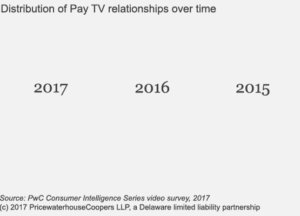In caseA recent report from Pricewaterhouse Coopers LLC (PwC), the “Consumer Intelligence Series Video Survey, 2017 report” claims that the same number of people who subscribe to pay-TV also subscribe to the Netflix video streaming service. The 73% subscriber number from the recently published report reflects chronic subscriber turn (loss) for the former (pay-TV sector) and explosive growth for Netflix.

Netflix reached parity with pay-TV as subscriptions continued to erode an additional 3% this year for the mighty cable and satellite industry, down from 76% in 2016 and 79% in 2015, PwC stated. Those numbers are likely to continue to shrink for pay-TV as a whopping 82% of respondents said it was live sports that was keeping them connected with pay-TV, and would “end or trim the pay-TV subscription if they no longer needed to access live sports.” In their NY focus groups PwC found that a whopping 91% of ‘sports fans’ subscribe to pay-TV for access to live games.
Word is spreading that the ESPN sport exclusive with pay-TV is already over. Sling currently offers several ESPN channels on a modest subscription basis, far less than even introductory cable offers. Additionally, OTA (over the air) local channels offer no cost live sports, accessible using the simple digital TV antenna and tuner provided in most flat screen sets today.
Beyond Netflix, a drill down into the PwC report also shows high adoption of new video streaming services, with 46% of all respondents to the survey acquiring within the last six months.
The group characterizes TV viewers as ‘traditional pay-TV subscribers’, ‘cord cutters’ (those who have given up their pay-TV subscriptions), ‘pay-TV trimmers’ (those who have reduced pay-TV services and augmented viewing with video streaming services) and finally ‘cord nevers’ (those who have never subscribed. ‘Trimmers’ are the most involved—they have five services on average, including Pay TV.
One price consumers may be paying for the move away from pay-TV is the convenience of channel surfing. Á la carte viewing requires changes in viewing behavior that is long entrenched from the early baby-boomer generation that started with the notion of just three or four TV channels (with perhaps a few more independents in larger designated market areas (DMA’s).
Advent of Pay TV Causes Growth
The watershed moment came with the advent of pay-TV and the explosive growth in viewing options to some 50 plus or more pay-TV channels. But more content did not translate into a higher quality viewing experience, as evidenced by the declaration that came to characterize pay-TV, “50 channels and nothing to watch!” And even while the number of viewing options grew over the years, the only thing that seemed to change was the constant increase in subscription prices, along with the length and volume or the commercial breaks. In this millennium, the saying is “150 channels and nothing to watch”.
But new media hub technology, like the recent Roku 4 and others, has done a superior job in consolidating all those streaming services into a content portal complete with voice search options. The services list all content sources, and pricing and other data giving the viewer the lowest cost, highest resolution options available for streaming.
So with the Netflix video streaming’s continued subscriber growth now at parity, perhaps the pay-TV industry will finally have to respond to the advent of á la carte viewing and the end of the multi-tier bundled pricing model (that gave us 150 channels of ‘nothing to watch’) has finally come to the new millennium. It will once again prove that competition does result, ultimately, in delivering what the customer wants. Provide it, or face the consequences. — Stephen Sechrist
Note: Regarding the Consumer Intelligence Series Video Survey, 2017 PwC said the initial survey was conducted in October 2017, PwC surveyed a sample of 1,986 Americans, ages 18 to 59, with annual household incomes above $40,000. They then analyzed results against similar studies conducted in Fall 2016, 2015, 2014, and 2013, plus conducted two consumer focus groups in New York.
Netflix Adds an Extra 5.3 Million Subscribers in Q3 2017
Netflix Adds HDR Support for Windows 10 PCs
Netflix and Deutsche Telekom Seal International Deal
Disney Streaming Service Will be “Substantially Cheaper” than Netflix
IHS Analyst Says Netflix is Having a “Significant Impact” in CEE

